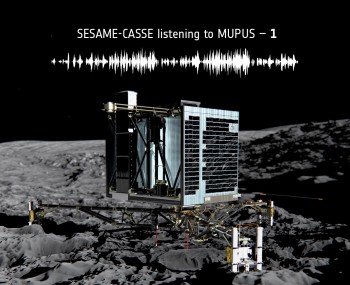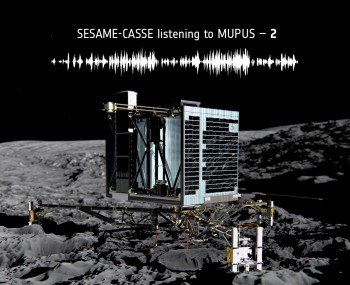Philae’s SESAME-CASSE ‘listened’ to the lander’s MUPUS instrument hammer the surface of Comet 67P/Churyumov-Gerasimenko last November. Martin Knapmeyer from the German Aerospace Centre, DLR, tells us more.
SESAME-CASSE is the Cometary Acoustic Surface Sounding Experiment located in the lander’s feet. It takes the form of three accelerometers, each of which records acceleration in three directions (one vertical and two horizontal). MUPUS comprises the Multi-Purpose Sensors for Surface and Subsurface Science – including the MUPUS penetrator that was activated towards the end of Philae’s first science sequence on 14 November 2014.
It was recognized early in the preparation of both experiments that the hammering mechanism of MUPUS, which drives a thermal probe into the comet’s surface, would serve as an acoustic source for ‘sounding’ the subsurface with CASSE. The determination of the propagation velocity of sound would allow scientists to look at possible layering in the comet’s surface and subsurface materials, important for understanding its evolution.
The CASSE instrument listened to the hammering of MUPUS for 2h 15 min. Due to memory limitations, CASSE was not able to take continuous recordings, but only a few seconds at a time. Several waiting periods were also included to give MUPUS time to reach depths of 10 cm, 20 cm, and 30 cm. A total of 15 hammer strokes were recorded, and one of the recordings contains two signals (the first sound, left, is heard at about 3 and 9 seconds respectively). The time between the strokes matches the charge time of the hammer mechanism expected at that time, thus this particular recording proves that CASSE was really recording hammer strokes.
The second sound file (below) contains hammer stroke no. 129 (as determined from the MUPUS housekeeping catalogue), which was recorded on Philae’s +Y foot. This stroke was executed at the highest energy level of the hammer system. All three channels of the +Y foot are mixed into the sound file, which is presented at real playback speed, in stereo. The signals on the other two feet were, in this case, much weaker and their recordings would mainly add to the background noise.
By looking at the strength and quality of the signals received by each foot, conclusions could be drawn about the orientation of Philae on the surface of the comet. Signal quality differs between feet, but several strokes were recorded on all three feet. From this the CASSE team concludes that all three feet of Philae have mechanical connection to the surface.
The CASSE team can also rule out that signals propagated through the structure of the lander only, since we see arrival time delays of several milliseconds between the individual feet, while delays due to asymmetries in the lander would amount to less than the sampling interval (i.e. microseconds). Signals traveling through Philae’s structure would thus arrive synchronously at all feet rather than foot by foot.
“The CASSE listening experiment has proved to be the first active seismic experiment conducted on a celestial body since the lunar seismic profiling experiment carried out by Apollo 17 astronauts on the Moon in 1972,” says Martin.
He adds: “The geological interpretation of our comet data is still ongoing. We obtained very low wave propagation velocities, typical for loose, highly porous materials but we still have to analyse what clues on layering we have in order to reconcile this with the inability of MUPUS to significantly penetrate the ground.”











Discussion: 2 comments
First of all, thank you very much for releasing these sounds with WAV format. Much better than mp3 etc. And….
Happy #CometLanding Anniversary!!!!
The first sound is super interesting, isn’t it?!! Why do the two hammering sounds in it sound so different?? Because of MUPUS’s mechanism/behaviour? The 1st hammer hit in this file did some vital progress?? Hope it’s the latter and the mission would gets more informations about the terrain beneath Philae from this sound!!
Have a good day everybody!!
This blog entry could possibly give a partial explanation regarding the different sounding hammer strokes: https://blogs.esa.int/rosetta/2014/11/18/philae-settles-in-dust-covered-ice/
“Before going into hibernation in the early hours of 15 November 2014, the Philae lander was able to conduct experiments and return its data to Earth.”
“… or because the probe had been pushed into a cold dust pile,…”
“The probe then started to hammer itself into the subsurface, but was unable to make more than a few millimetres of progress even at the highest power level of the hammer motor.”